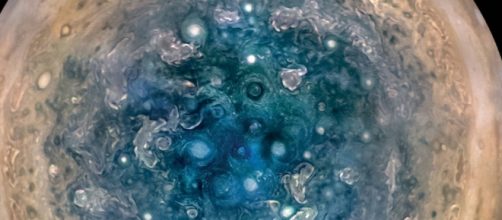The latest images made by Juno on the Planet Jupiter portray what is already known about Jupiter; a turbulent, enormous and complex world, with cyclones, such as the great red spot, that are as big as the the earth in area. It has been fund that Jupiter is more dynamic than already thought and that the poles are covered by dense storms; inspecting down the clouds of gas, it has been discovered that these zones are not homogenous. The magnetic field also seems to be stronger and irregular than already thought. Each flyby made by Juno, allows scientists to gather more data about the gas giant planet.
Juno mission
Juno mission was launched last year on August 5, 2011 and it arrived at Jupiter 4 years and 11 months later, on July 4, 2016. On this date, Juno flew at approximately 4,200 km (2,600 miles) above the clouds covering Jupiter, revealing for the first time photographic images of Jupiter at such a close distance. Since that first date, Juno has completed 5 Jupiter flybys and on each approach to the gas giant planet it has used its science instruments to record imaging, microwave radiation and magnetosphere data, giving scientists with sufficient data that is providing new insights into Jupiter.
Microwave and magnetosphere analysis
The information provided by Juno´s Microwave Radiometer (MWR) indicate that the planet´s belts and spots are not homogenous; on the contrary, they are variable with ammonia increasing a few hundreds of miles down Jupiter´s atmosphere.
Although, Jupiter’s magnetic field was considered as the most intense in the solar system, new measurements show that it is stronger than previously thought, even ten times stronger than the strongest magnetic field on earth. It´s been discovered that Jupiter’s magnetic field is irregular, suggesting that it could be generated by a dynamo process above in the layer of metallic hydrogen.
Juno´s orbit around Jupiter
Juno was placed on a polar orbit around Jupiter and it approaches Jupiter every 53 days, spending almost the majority of this time away from the gas giant. During the two hours that Juno spends flying from north to south of Jupiter, it uses all of its eight science instruments to collect data that is eventually sent to earth for analysis.
On the next flyby, which will occur on July 11, 2017, Juno is expected to fly directly above the Great Red Spot, having the opportunity to collect science data from this anti-cyclonic storm.
The observations made by Juno have also revealed that the auroras on Jupiter seem to be produced by a process that is different to the process that produces the auroras on earth.


